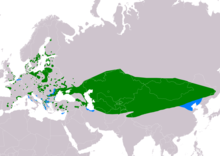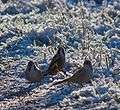Bearded reedling
The bearded reedling (Panurus biarmicus) is a small, sexually dimorphic reed-bed passerine bird. It is frequently known as the bearded tit, due to some similarities to the long-tailed tit, or the bearded parrotbill. It is the only species in the family Panuridae.
| Bearded reedling | |
|---|---|
.jpg) | |
| Adult male in Kent, England | |
.jpg) | |
| Adult female in Kent, England | |
| Scientific classification | |
| Kingdom: | Animalia |
| Phylum: | Chordata |
| Class: | Aves |
| Order: | Passeriformes |
| Family: | Panuridae Des Murs, 1860 |
| Genus: | Panurus Koch, 1816 |
| Species: | P. biarmicus |
| Binomial name | |
| Panurus biarmicus | |
 | |
| Range of P. biarmicus Resident Non-breeding | |
| Synonyms | |
| |
Taxonomy and systematics
The bearded reedling was first described by Carl Linnaeus in his 10th edition of Systema Naturae in 1758. He placed it in the genus Parus with the tits. The species has since been placed with the parrotbills in the family Paradoxornithidae, after they were removed from the true tits in the family. More recent research suggests it is a unique songbird – no other living species seems to be particularly closely related to it.[2] The species is now placed in the monotypic family Panuridae. Molecular phylogenetic studies have shown that the bearded reedling is most closely related to the lark family Alaudidae.[3] The current genus name, Panurus, is from Ancient Greek panu, "exceedingly", and ουρά, "tail". The specific biarmicus is from "Biarmia", a Latinised form of Bjarmaland, formerly part of what is now the Arkhangelsk Oblast area of Russia.[4]
Description
This is a small orange-brown bird, L 16.5 cm, with a long tail and an undulating flight. The bill is yellow-orange. The male has a grey head and black moustaches (not a beard); the lower tail coverts are also black. The female is generally paler, with no black moustache. Flocks often betray their presence in a reedbed by their characteristic "ping" call.
Distribution and habitat
This species is a wetland specialist, breeding colonially in large reed beds by lakes or swamps. It eats reed aphids in summer, and reed seeds in winter, its digestive system changing to cope with the very different seasonal diets.[5]
The bearded reedling is a species of temperate Europe and across the Palearctic. It is resident, and most birds do not migrate other than eruptive or cold weather movements. It is vulnerable to hard winters, which may kill many birds. The English population of about 500 pairs is largely confined to the south and east with a small population in Leighton Moss in north Lancashire. In Ireland there is a small but growing population mainly in County Wexford. The largest single population in Great Britain is to be found in the reedbeds at the mouth of the River Tay in Perth and Kinross, Scotland, where there may be in excess of 250 pairs.[6]
 Juvenile (top), adult males (center) and adult female (front)
Juvenile (top), adult males (center) and adult female (front) Flock in natural habitat
Flock in natural habitat Three males
Three males ID composite
ID composite- A juvenile pecks insects from a cobweb
References
- BirdLife International (2012). "Panurus biarmicus". IUCN Red List of Threatened Species. 2012. Retrieved 26 November 2013.CS1 maint: ref=harv (link)
- Johansson, Ulf S.; Fjeldså, Jon; Bowie, Rauri CK (2008). "Phylogenetic relationships within Passerida (Aves: Passeriformes): a review and a new molecular phylogeny based on three nuclear intron markers". Molecular Phylogenetics and Evolution. 48 (3): 858–876. doi:10.1016/j.ympev.2008.05.029. PMID 18619860.
- Oliveros, C.H.; et al. (2019). "Earth history and the passerine superradiation". Proceedings of the National Academy of Sciences of the United States of America. 116 (16): 7916–7925. doi:10.1073/pnas.1813206116. PMC 6475423. PMID 30936315.
- Jobling, James A (2010). The Helm Dictionary of Scientific Bird Names. London: Christopher Helm. pp. 71, 291. ISBN 978-1-4081-2501-4.
- Robson, Craig (2007). "Family Paradoxornithidae (Parrotbill)". In del Hoyo, Josep; Elliott, Andrew; Christie, David (eds.). Handbook of the Birds of the World. Volume 12: Picathartes to Tits and Chickadees. Barcelona: Lynx Edicions. pp. 292–320. ISBN 978-84-96553-42-2.
- Forrester R.W. & Andrews I.J Eds (2007) The Birds of Scotland Volume 2 Scottish Ornithologists' Club ISBN 978-0-9512139-0-2
External links
| Wikimedia Commons has media related to Panurus biarmicus. |
- Bearded reedling videos, photos & sounds on the Internet Bird Collection
- Bearded Reedling song/call at xeno-canto.com
- Ageing and sexing (PDF; 3.1 MB) by Javier Blasco-Zumeta & Gerd-Michael Heinze
